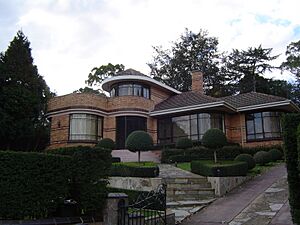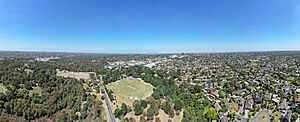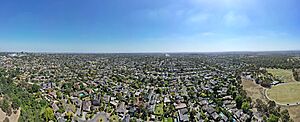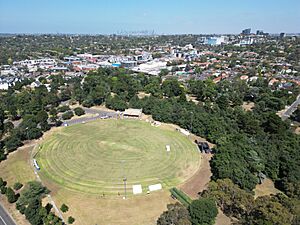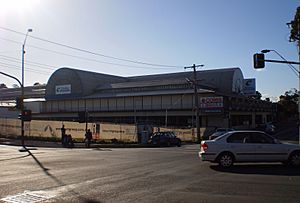Heidelberg, Victoria facts for kids
Quick facts for kids HeidelbergMelbourne, Victoria |
|||||||||||||||
|---|---|---|---|---|---|---|---|---|---|---|---|---|---|---|---|

Austin Hospital dominates the Heidelberg skyline (as viewed from Westerfolds Park)
|
|||||||||||||||
| Population | 7,360 (2021 census) | ||||||||||||||
| • Density | 2,730/km2 (7,100/sq mi) | ||||||||||||||
| Established | 1838 | ||||||||||||||
| Postcode(s) | 3084 | ||||||||||||||
| Elevation | 51 m (167 ft) | ||||||||||||||
| Area | 2.7 km2 (1.0 sq mi) | ||||||||||||||
| Location | 11 km (7 mi) from Melbourne | ||||||||||||||
| LGA(s) | City of Banyule | ||||||||||||||
| State electorate(s) | Ivanhoe | ||||||||||||||
| Federal Division(s) | Jagajaga | ||||||||||||||
|
|||||||||||||||
Heidelberg is a suburb located in Melbourne, Victoria, Australia. It is about 11 kilometers (7 miles) northeast of Melbourne's main city center. In 2021, about 7,360 people lived there.
Heidelberg was once a large town outside Melbourne. After World War II, Melbourne grew northwards and Heidelberg became part of the city. It used to have its own town center and local government.
Heidelberg is famous for the Heidelberg School. This was an impressionist art movement. It started in and around the town in the late 1800s.
Contents
History of Heidelberg
The land in Heidelberg was first sold in 1838. This was very early in Australia's history, as Melbourne was founded only three years before. By 1840, a planned town called Warringal was set up. This name came from an Aboriginal word for "eagle's nest."
Later, a land agent changed the name to Heidelberg. He named it after the city of Heidelberg in Germany. During World War I, some people wanted to change the name again. They suggested names like Georgetown, but the name Heidelberg stayed.
When Heidelberg was first settled, people traveled there from Melbourne by a dirt track. In 1841, a group was formed to manage the road. This group was even older than the Melbourne Town Council. By the late 1840s, the road had a toll booth and a smooth surface. Heidelberg became a popular spot for tourists. People came to enjoy the views and countryside. In 1846, Joseph Hawdon built his large Gothic house, Banyule Homestead, overlooking the Yarra Valley.
The Post Office opened in 1853 as Warringal. It was renamed Heidelberg in 1865. Heidelberg became a Shire (a type of local government area) on January 27, 1871.
In the 1880s, Heidelberg's beautiful countryside attracted many artists. There were no public services or a railway yet, so houses were often empty and cheap to rent. Artists like Tom Roberts, Arthur Streeton, and Frederick McCubbin moved to Eaglemont in 1888. They formed what became known as the "Heidelberg School" of Australian art.
Heidelberg officially became a city on April 11, 1934. However, much of its land was still rural. The Heidelberg Town Hall was built in 1937. More homes and shops were built near Heidelberg Road and the Melbourne to Hurstbridge railway line. This railway line cut through the area. Stations along this line include Darebin, Ivanhoe, Eaglemont, Heidelberg, Rosanna, Macleod, Watsonia, and Greensborough.
Heidelberg West did not have a railway line. It was not very populated until the 1950s. The Housing Commission of Victoria built many homes there. It also became the site for the athletes' village during the 1956 Melbourne Olympic Games.
By the 1970s, most of Heidelberg Municipality was developed with homes. Shopping areas were mainly along streets. However, a separate shopping center was built in Heidelberg West in 1956. It was designed by the Housing Commission, inspired by American ideas.
Heidelberg City was mostly joined with part of Eltham Shire on December 15, 1994. This formed the new Banyule City.
You can still see signs of Heidelberg's long history today. The cemetery on Upper Heidelberg Road has some of Victoria's oldest graves. The Heidelberg Old Cemetery has graves from 1852. Heidelberg Primary School opened in 1854. Banyule Homestead was built in 1846. St John's Anglican Church was built in 1849. The Old England Hotel first opened in 1848. All these buildings are still standing.
Heidelberg's Population
In the 2016 Census, there were 6,225 people living in Heidelberg. About 67.1% of people were born in Australia. Other common birthplaces included India (3.1%), China (2.8%), England (2.6%), and Italy (1.9%).
Most people (69.7%) spoke only English at home. Other languages spoken included Mandarin (3.4%), Italian (3.2%), and Greek (2.0%). For religion, the most common answers were No Religion (34.8%) and Catholic (27.6%).
Local Facilities
The main office for Austin Health is in Heidelberg at the Austin Hospital. The Austin Hospital has been greatly updated recently. It now also includes the Mercy Hospital for Women. Together, these two hospitals form the largest hospital in Victoria.
The Heidelberg Shopping Centre, also known as "Burgundy Street," has been improved. It was a bit old in the 1980s. But now, with a new supermarket and many cool cafes, it's a much nicer place to live. Because of this, house prices have gone up a lot.
"Burgundy Street" is now called the Heidelberg Central Shopping Precinct. It has over 230 shops and businesses. Over $1 million has been spent to improve the area. This includes things like new footpaths, trees, seating, and bike racks. All the street furniture is painted 'Burgundy' to show the shopping area's limits. The historic Old England Hotel is also located here.
Melbourne Polytechnic has a campus in Heidelberg where students can study. The Austrian Club Melbourne moved to its current Heidelberg location in 1984.
The Community radio station 96.5 Inner FM broadcasts from studios inside Warringal Shopping Centre. For public library services, the nearest library is in Ivanhoe, provided by Yarra Plenty Regional Library.
Warringal Shopping Centre
Warringal Shopping Centre opened in 1987. It is a shopping center located on Rosanna Road, with an entrance on Burgundy Street. The center serves about 41,000 people from nearby suburbs. These include Heidelberg, Viewbank, Rosanna, Ivanhoe, and Eaglemont. Since the Austin and Mercy Hospitals opened, more young professionals are moving to the area. This has led to more demand for new housing.
In 2007, the center was updated. This included adding an Aldi supermarket. The center is about 12 kilometers (7.5 miles) northeast of the Melbourne city center. It is a single-level shopping center with a small department store and two supermarkets.
Getting Around Heidelberg
Most people in Heidelberg use private cars to get around. The main roads are Burgundy Street (which is also the main shopping street), Rosanna Road, Upper Heidelberg Road, and Banksia Street.
Heidelberg railway station is in the suburb. It is on the Hurstbridge line and is served by Metro Trains Melbourne trains. There is also a local bus network that serves the area.
Heidelberg has a network of bike paths. These include paths on roads and separate bike lanes. The Main Yarra Trail is also nearby.
Sports in Heidelberg
The Heidelberg Football Club plays Australian rules football. They compete in the Northern Football League. Their home ground is at Warringal Parklands. The Heidelberg West Football Club also plays in the Northern League. They play at Heidelberg Park, which is across from Warringal.
Heidelberg United is a soccer club based in the suburb. They play in the Victorian Premier League. They used to play in the National Soccer League, which was the league before the A-League. It is one of Victoria's biggest soccer clubs.
Golfers can play at the Heidelberg Golf Club. It is on Main Road, in the nearby suburb of Lower Plenty.
Famous People from Heidelberg

- Jim May (1934–2023) – A chemical engineer and businessman.
- Heath Shaw (1985–) – An Australian rules footballer.
- Brent Stanton (1986–) – An Australian rules footballer.
- Tom Wills (1835–1880) – A famous cricketer and one of the people who helped create Australian rules football.




